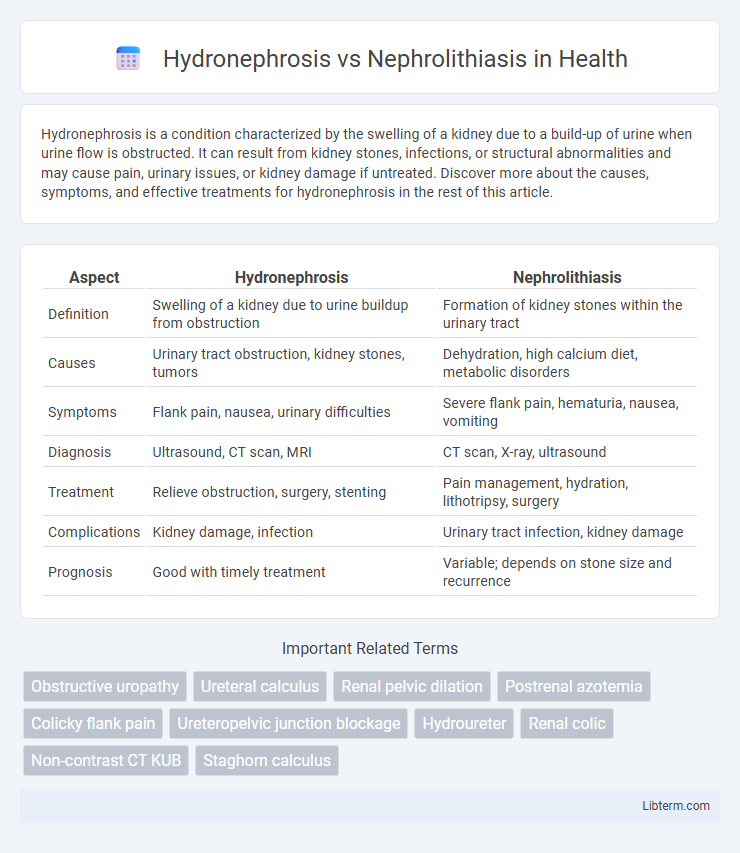Hydronephrosis is a condition characterized by the swelling of a kidney due to a build-up of urine when urine flow is obstructed. It can result from kidney stones, infections, or structural abnormalities and may cause pain, urinary issues, or kidney damage if untreated. Discover more about the causes, symptoms, and effective treatments for hydronephrosis in the rest of this article.
Table of Comparison
| Aspect | Hydronephrosis | Nephrolithiasis |
|---|---|---|
| Definition | Swelling of a kidney due to urine buildup from obstruction | Formation of kidney stones within the urinary tract |
| Causes | Urinary tract obstruction, kidney stones, tumors | Dehydration, high calcium diet, metabolic disorders |
| Symptoms | Flank pain, nausea, urinary difficulties | Severe flank pain, hematuria, nausea, vomiting |
| Diagnosis | Ultrasound, CT scan, MRI | CT scan, X-ray, ultrasound |
| Treatment | Relieve obstruction, surgery, stenting | Pain management, hydration, lithotripsy, surgery |
| Complications | Kidney damage, infection | Urinary tract infection, kidney damage |
| Prognosis | Good with timely treatment | Variable; depends on stone size and recurrence |
Introduction to Hydronephrosis and Nephrolithiasis
Hydronephrosis is the swelling of a kidney due to a build-up of urine caused by an obstruction or reflux, impairing normal urine flow. Nephrolithiasis, commonly known as kidney stones, involves the formation of hard mineral and salt deposits within the kidneys, leading to pain and potential urinary blockages. Both conditions affect urinary tract function but differ in etiology and clinical presentation, with hydronephrosis often resulting from obstruction and nephrolithiasis stemming from crystal aggregation.
Overview of Urinary Tract Anatomy
The urinary tract comprises the kidneys, ureters, bladder, and urethra, responsible for urine production, transport, storage, and elimination. Hydronephrosis occurs when urine flow is obstructed, causing kidney swelling due to pressure buildup in the renal pelvis and calyces, often linked to blockages within the urinary tract. Nephrolithiasis involves the formation of kidney stones within the renal calyces or pelvis that can obstruct urine flow, leading to pain and potential hydronephrosis if left untreated.
Causes of Hydronephrosis
Hydronephrosis is primarily caused by obstruction of urine flow due to kidney stones, tumors, congenital abnormalities, or enlarged prostate, leading to swelling of the kidney. Unlike nephrolithiasis, which involves the formation of kidney stones within the urinary tract, hydronephrosis results from blockage that causes urine to accumulate and increase pressure in the renal pelvis. Understanding the underlying cause of hydronephrosis is crucial for targeted treatment and prevention of kidney damage.
Causes of Nephrolithiasis
Nephrolithiasis primarily results from supersaturation of urine with stone-forming substances such as calcium, oxalate, and uric acid, leading to crystal aggregation and stone formation. Risk factors include dehydration, metabolic disorders like hyperparathyroidism, dietary factors high in sodium and protein, and genetic predisposition. Unlike hydronephrosis, which is caused by urinary tract obstruction, nephrolithiasis originates from biochemical abnormalities promoting stone development within the renal system.
Key Differences Between Hydronephrosis and Nephrolithiasis
Hydronephrosis is characterized by the swelling of a kidney due to urine buildup from obstruction, whereas nephrolithiasis involves the formation of kidney stones within the urinary tract. Hydronephrosis primarily results from urinary tract obstructions such as strictures or stones, causing dilation of the renal pelvis and calyces, while nephrolithiasis is defined by solid crystal aggregations that may obstruct urine flow and cause severe pain. Diagnostic imaging such as ultrasound or CT scans differentiates hydronephrosis as fluid accumulation versus nephrolithiasis as calculi presence, essential for accurate treatment planning.
Common Signs and Symptoms
Hydronephrosis commonly presents with flank pain, urinary urgency, and sometimes hematuria, resulting from urine flow obstruction causing kidney swelling. Nephrolithiasis often causes sudden, severe renal colic, hematuria, and nausea due to kidney stones irritating or blocking the urinary tract. Both conditions can cause discomfort and urinary symptoms but differ in pain patterns and underlying causes.
Diagnostic Approaches and Imaging
Hydronephrosis is typically diagnosed through ultrasound, which effectively detects renal pelvic dilation, whereas nephrolithiasis diagnosis relies heavily on non-contrast helical CT scans for identifying the size and location of kidney stones. Intravenous pyelography (IVP) and CT urography offer detailed imaging for both conditions but are less commonly first-line compared to ultrasound and CT. Doppler ultrasound can assess urinary obstruction in hydronephrosis, while kidney stone composition analysis may require dual-energy CT for precise characterization.
Treatment Options and Management Strategies
Hydronephrosis treatment involves relieving urinary obstruction through procedures such as ureteral stenting or nephrostomy, alongside managing underlying causes like strictures or tumors. Nephrolithiasis management includes pain control, hydration, and interventions like extracorporeal shock wave lithotripsy (ESWL), ureteroscopy, or percutaneous nephrolithotomy based on stone size and location. Both conditions require monitoring renal function and preventing recurrent complications through lifestyle modifications and appropriate medical therapy.
Potential Complications and Prognosis
Hydronephrosis, characterized by the swelling of a kidney due to urine buildup, can lead to complications such as kidney infections, permanent kidney damage, and impaired renal function if untreated. Nephrolithiasis, or kidney stones, often causes obstruction leading to severe pain, urinary tract infections, and potential kidney failure in severe cases. Prognosis depends on the severity and timeliness of treatment; hydronephrosis may result in irreversible damage if chronic, while nephrolithiasis generally has a favorable outcome with prompt stone removal and preventive measures.
Prevention and Patient Education
Effective prevention of hydronephrosis and nephrolithiasis centers on maintaining optimal hydration and dietary modifications, such as reducing sodium and oxalate intake to minimize stone formation risk and urinary obstruction. Patient education emphasizes the importance of regular medical check-ups, early symptom recognition like flank pain or urinary discomfort, and adherence to prescribed treatments to prevent complications including kidney damage. Customized lifestyle counseling incorporating fluid intake goals and nutritional guidance enhances patient compliance and outcomes in managing both conditions.
Hydronephrosis Infographic

 libterm.com
libterm.com